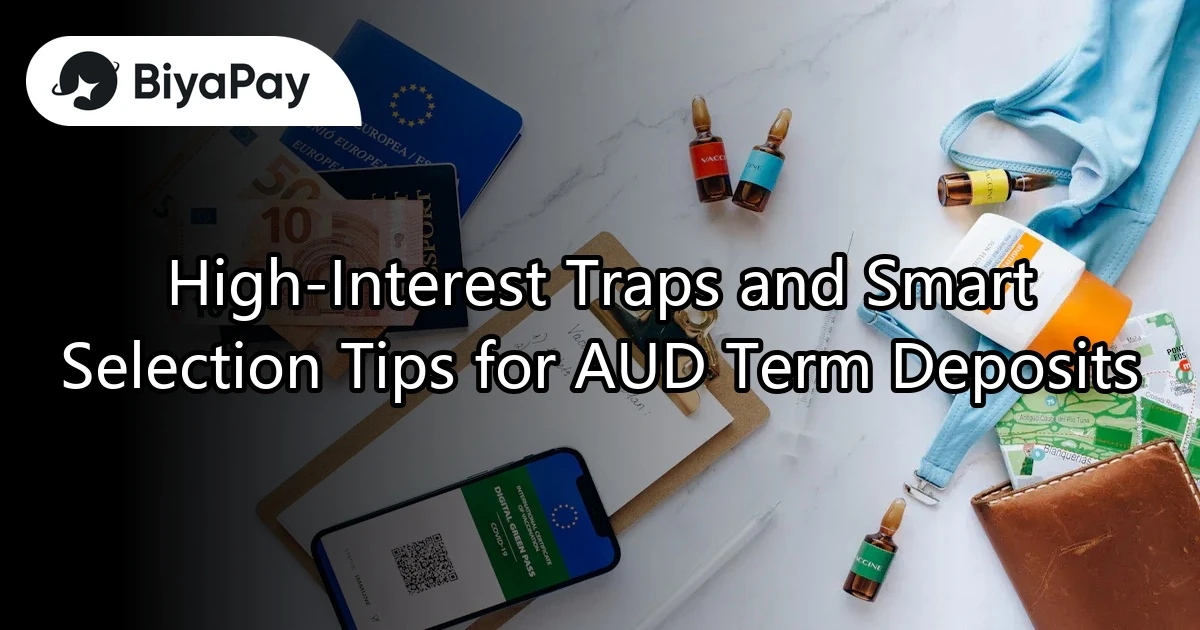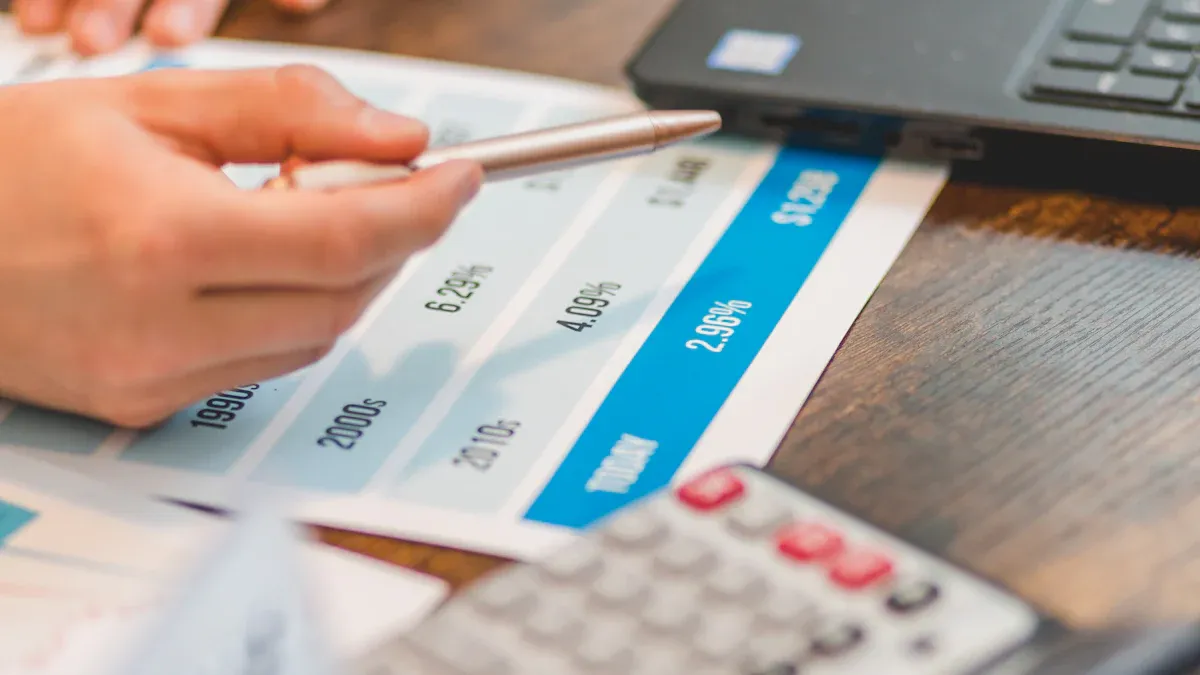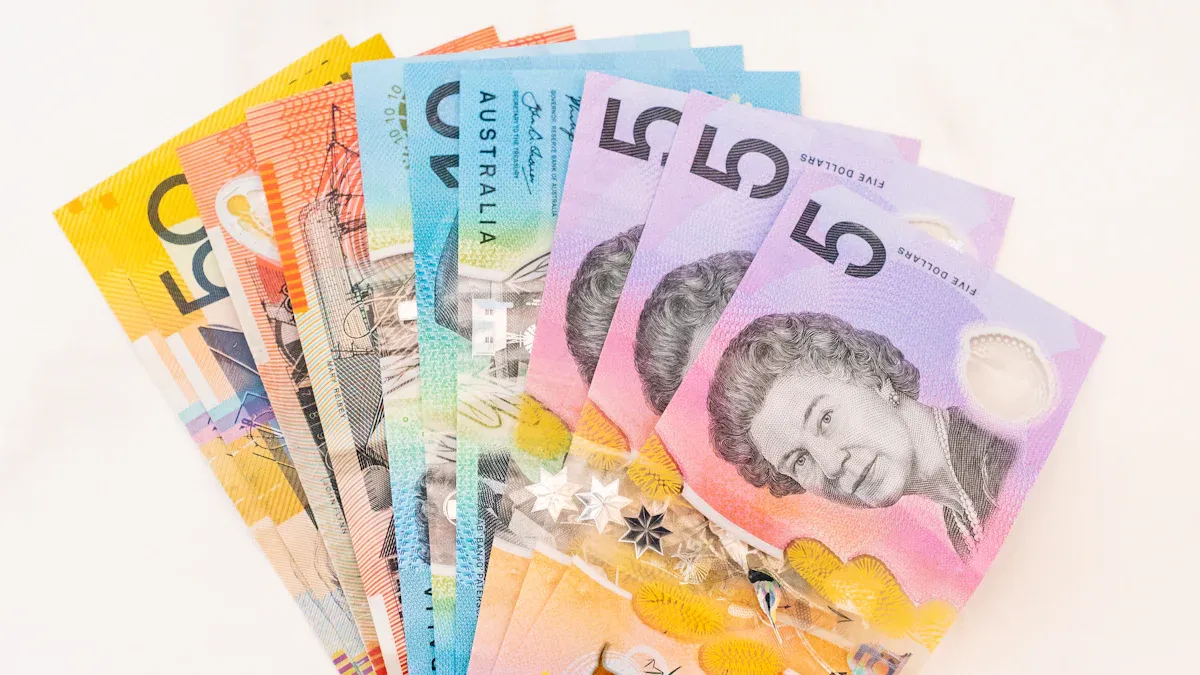- EasyCard
- Trade
- Help
- Announcement
- Academy
- SWIFT Code
- Iban Number
- Referral
- Customer Service
- Blog
- Creator
High-Interest Traps and Smart Selection Tips for AUD Term Deposits

Image Source: unsplash
Have you noticed that many AUD term deposit products on the market boast high interest rates? In fact, high interest does not necessarily mean you’ll earn more. You need to look closely at every detail from multiple perspectives and not just focus on the surface interest rate. Remember three key principles: compare extensively, carefully review terms, and diversify investments. Actively seek information and do your homework to avoid common traps.
Key Points
- High interest does not mean high returns; pay attention to additional conditions and hidden fees to avoid being misled by surface rates.
- Exchange rate fluctuations can affect actual returns; short-term exchange risks are high, while long-term holding can better balance volatility.
- Before choosing an AUD term deposit, compare products from different banks and select an appropriate term based on liquidity needs.
- Read terms carefully and assess risks to understand all fees and restrictions, avoiding losses from early withdrawal.
- Diversifying investments can reduce risks and enhance long-term returns; don’t concentrate funds in a single product or bank.
High-Interest Traps

Image Source: pexels
Interest Rate Myths
You may see some Hong Kong banks offering AUD term deposit rates that seem shockingly high, with short-term rates even advertised as high as 10%. You might think the higher the rate, the more you’ll earn. But that’s not necessarily true. You need to note that these high-interest offers often come with additional conditions, such as high minimum deposit requirements or restrictions to new funds only. If you only look at the interest rate and ignore other details, you might miss out on better options. High interest does not equal high returns, as other risks and costs need to be considered.
Hidden Fees
Do you think opening an AUD term deposit only involves looking at the interest rate? In fact, many bank products come with hidden fees. Pay special attention to the following:
- Some banks charge account opening fees, early withdrawal fees, or currency exchange fees, which may not be clearly stated upfront.
- Some promotional rates require you to convert HKD to AUD, and banks charge a spread during conversion, a cost often overlooked.
- Some products have auto-renewal features; if you forget to cancel, fees may be automatically deducted, or the renewal rate may be lower.
You may have encountered situations where some services appear low-cost but actually have many hidden fees. For example, some apps’ VIP plans range from USD 8 to USD 520 per month, with additional charges for points or virtual currency top-ups. If you don’t read the terms carefully, you might be automatically charged without knowing, and it could be hard to recover the fees. This is also common in financial products, so you must ask about all fee details.
Exchange Rate Risks
When choosing an AUD term deposit, you must consider the risks from exchange rate fluctuations. You might think AUD interest rates are high and want to convert HKD to AUD to earn interest. But if the AUD exchange rate is high at the time of conversion and later falls when converting back to HKD, your actual returns could be significantly reduced.
Based on past statistics for USD against other currencies, short-term exchange rate fluctuations are significant, with a monthly standard deviation as high as 2.38% and an annualized standard deviation of 8.26%. If you exchange at a high rate, short-term exchange losses could exceed 10%. However, in the long term, the asset’s returns may offset exchange rate fluctuations. For example, someone who converted to USD at a high rate in early 2016 still profited after five years due to portfolio returns despite a drop in the exchange rate. You need to understand that short-term currency speculation carries high risks, while long-term holding has a better chance of balancing volatility.
Liquidity Restrictions
When choosing an AUD term deposit, you also need to consider liquidity. Term deposits typically have fixed terms, such as one month, three months, or one year. Once deposited, you cannot withdraw funds during the term without paying early withdrawal fees or even losing all interest. If you need funds in the future, this restriction could put you in a difficult position. So, based on your financial plans, choose an appropriate term to avoid sacrificing flexibility for high interest.
Promotional Misleading
Many banks use terms like “high interest” or “limited-time offers” to attract you, but you need to be cautious of these marketing tactics. Some products are only for new funds or new customers, and rates drop significantly after the promotional period. Some banks emphasize “higher than HKD term deposits” but fail to mention risks, such as AUD term deposits not being covered by Hong Kong’s Deposit Protection Scheme. If you only focus on promotional slogans, you may overlook the product’s restrictions and risks. Actively inquire and carefully read terms to make informed choices.
Smart Selection Tips

Image Source: unsplash
Comparing AUD Term Deposit Products
To choose the most suitable AUD term deposit, the first step is to compare products from different banks. Interest rates offered by Hong Kong banks vary widely, and sometimes the same bank offers different rates for different terms. For example, some banks offer up to 4.5% for 6-month or 12-month terms, but short-term rates (like 7 days or 1 month) may only be around 2%. You can use a table or list to record each bank’s rates, minimum deposits, and promotional conditions for easy comparison.
Tip: Use online banking services to instantly check the latest rates and enjoy exclusive online offers, making account opening and renewals more convenient.
Choose a term based on your liquidity needs. Short terms offer flexibility, while long terms usually have higher rates. Don’t just chase high interest; consider when you might need the funds.
Reviewing Terms
Never focus only on the interest rate; carefully read all terms. Different banks’ AUD term deposit products may have significantly different terms. Pay special attention to the following key terms, as they directly affect your risks and returns:
| Key Term Category | Risk and Return Metrics Explained with Data |
|---|---|
| Profit Test Metrics | Ratio of discounted net profit (loss) to discounted premium, ROA, ROE, IRR, CSM Margin |
| Sensitivity Analysis | Sensitivity tests for investment return, mortality, assumed risk occurrence, lapse rate, and expense rate |
| Loss Distribution Model | Quantitative models for loss frequency, severity, and correlation |
| Reserve Risk Measurement | Quantitative analysis methods like cash flow testing and loss ratio methods |
| Credit Risk Quantification | Expected Credit Loss (ECL), Exposure at Default (EAD), Probability of Default (PD), Loss Given Default (LGD) |
You can request these data from the bank or review the product documentation. This way, you’ll have a clearer understanding of whether the product’s risk and return ratio is reasonable.
Risk Assessment
Learn to assess your risk tolerance. Although AUD term deposits are low-risk, foreign currency deposits still face exchange rate and policy risks. Ask yourself: Can you accept a reduction in principal or interest if the AUD depreciates? If you need funds urgently, will early withdrawal fees or loss of interest hurt you? You can use simple calculations to estimate worst-case losses, so you won’t be caught off guard by unexpected situations.
Exchange Rate Fluctuations
Exchange rate fluctuations are the biggest uncertainty for AUD term deposits. You convert HKD to AUD when depositing and back to HKD when withdrawing. If the AUD falls against USD or HKD, your actual returns may be offset. You can review the AUD’s exchange rate trends against USD over the past year to gauge volatility. You can also set a mental threshold, such as revisiting your strategy if the exchange rate drops by more than 5%.
Tip: Some banks offer “automatic foreign currency term deposit conversion” features, allowing you to set a target exchange rate for automatic conversion, reducing human error in judgment.
Bank Reputation
When choosing an AUD term deposit, the bank’s reputation is equally important. Choose a Hong Kong bank with a strong reputation, sufficient capital, and robust regulation. You can check the bank’s credit rating, past customer reviews, or whether it has been penalized by regulators. Large banks typically have lower risks and more reliable services. Don’t chase high interest at the expense of the bank’s stability.
Diversifying Investments
Don’t put all your funds into a single AUD term deposit or bank. Diversifying investments significantly reduces risks and enhances long-term returns. According to statistics:
- The probability of a single stock outperforming the market is only about 11%.
- Holding multiple stocks can increase the chance of outperforming the market to nearly 50%.
- From 1987 to 2017, about 47% of stocks in the U.S. Russell 3000 index lost value, over 30% fell by more than 50%, and only about 7% performed exceptionally well.
These data show that concentrated investments carry high risks. You can consider diversifying funds across different foreign currency term deposits, HKD term deposits, bonds, or funds. Even if one asset underperforms, the overall portfolio can still achieve stable returns. In the long run, diversified portfolios yield more stable returns, with more significant asset growth.
Tip: You can refer to Taiwan’s Yuanta Taiwan 50 (0050), which has an average annualized return of about 10% over the past 20 years. The long-term compounding effect is significant. Diversifying investments helps stabilize profits and reduces losses from single-market volatility.
Selection Process
Define Goals
First, ask yourself: Why do you want an AUD term deposit? Are you aiming for short-term interest or long-term asset diversification? Clarify your liquidity needs. If you’ll need the funds within six months, opt for short-term deposits. For long-term growth, consider longer terms. Clear goals prevent you from making poor decisions due to temporary high interest.
Gather Information
Visit the official websites of major Hong Kong banks to check the latest AUD term deposit rates. Use a table to record rates, minimum deposits (e.g., USD 1,000 or more), promotional conditions, and terms. You can also compare HKD term deposits and other foreign currency deposits to see what suits you best. Pay attention to exchange rates, such as the latest USD to AUD quote, as conversions affect actual returns.
Review Terms
Don’t just focus on interest rates; carefully read all terms. The following statistics can help you better understand product risks:
- The median is more reflective of market conditions than the mean, avoiding being misled by extreme values.
- Standard deviation and histograms can help estimate return volatility ranges.
- Use Excel’s AVERAGE() and STDEV() functions to calculate data and visualize it with charts for clarity.
- Break down data into ratios and analyze by time or region to uncover hidden risks.
- Simulate worst-case scenarios to see if you can handle them.
Risk and Return
Calculate actual returns, not just surface rates. Include conversion costs, fees, and taxes. Use a simple formula:
Actual Return = (Interest Income - Exchange Loss - Fees) / Principal
If the AUD falls against USD, your interest may be offset by exchange losses. Set a mental threshold, such as revisiting your strategy if the exchange rate drops by more than 5%.
Final Check
Double-check all information. Ensure you understand all terms and risks. Ask bank staff or consult experienced friends. Don’t rush decisions; take extra time to ensure you choose the most suitable product. This way, you can confidently enjoy the returns from AUD term deposits.
Remember, when choosing an AUD term deposit, clear steps are crucial:
- Compare products from different Hong Kong banks
- Carefully read terms
- Diversify investments and regularly review your portfolio
Bloomberg data shows that diversification and periodic adjustments can average costs and reduce forecasting pressure, achieving long-term annualized returns of over 10%. By actively gathering information and learning, your financial management will be more robust.
FAQ
Is there a minimum deposit amount for AUD term deposits?
Most Hong Kong banks set a minimum deposit amount, typically USD 1,000 or more. Check each bank’s requirements and exchange rates to avoid missing out on offers.
What happens if I withdraw early?
If you withdraw early, banks usually charge fees and may not pay interest. Ask about related fees to avoid losses.
Are AUD term deposits protected?
AUD term deposits are not covered by Hong Kong’s Deposit Protection Scheme. Choose reputable Hong Kong banks to reduce risks.
How do exchange rate fluctuations affect returns?
When converting HKD to AUD, the exchange rate directly impacts final returns. If the AUD depreciates, your interest and principal may shrink.
Can I open an AUD term deposit online?
You can open AUD term deposits through most Hong Kong banks’ online banking services. Online account opening sometimes offers exclusive promotions, making it convenient and fast.
Australian Dollar fixed deposits (e.g., Fubon Bank’s 4.5% or HSBC One’s 7-day 12.5%) offer low-risk income, but exchange rate fluctuations, hidden fees (like conversion spreads or early withdrawal penalties), and liquidity constraints can erode returns—how can you achieve flexible global wealth management? BiyaPay provides an all-in-one financial platform, enabling seamless trading of US and Hong Kong stocks without offshore accounts, extending the stability of AUD deposits to international investments in giants like Tencent and Alibaba.
Supporting USD, HKD, and 30+ fiat and digital currencies, real-time exchange rate tracking minimizes conversion losses, while global remittances to 190+ countries feature transfer fees as low as 0.5%, with swift delivery to meet global wealth management needs. A 5.48% annualized yield savings product, with no lock-in period, balances exchange rate volatility with steady returns. Sign up for BiyaPay today to integrate AUD fixed deposits’ low-risk benefits with BiyaPay’s worldwide financial solutions, creating a flexible, efficient wealth management experience!
*This article is provided for general information purposes and does not constitute legal, tax or other professional advice from BiyaPay or its subsidiaries and its affiliates, and it is not intended as a substitute for obtaining advice from a financial advisor or any other professional.
We make no representations, warranties or warranties, express or implied, as to the accuracy, completeness or timeliness of the contents of this publication.




Contact Us
Company and Team
BiyaPay Products
Customer Services
is a broker-dealer registered with the U.S. Securities and Exchange Commission (SEC) (No.: 802-127417), member of the Financial Industry Regulatory Authority (FINRA) (CRD: 325027), member of the Securities Investor Protection Corporation (SIPC), and regulated by FINRA and SEC.
registered with the US Financial Crimes Enforcement Network (FinCEN), as a Money Services Business (MSB), registration number: 31000218637349, and regulated by FinCEN.
registered as Financial Service Provider (FSP number: FSP1007221) in New Zealand, and is a member of the Financial Dispute Resolution Scheme, a New Zealand independent dispute resolution service provider.




















